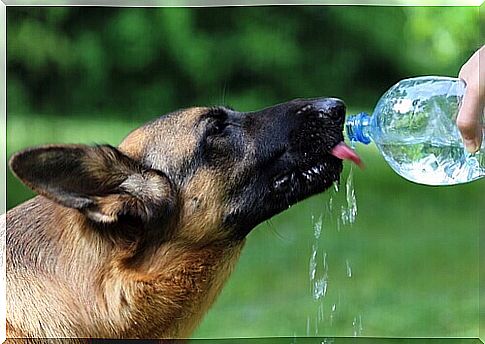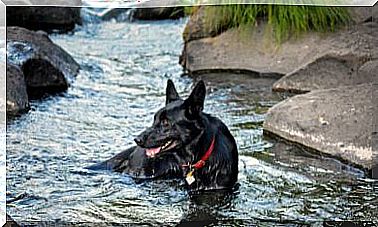Can Dogs Sweat?

Dogs do not have sweat glands all over their bodies, so they use their paw pads and tongue to cool off. But here we’ll learn how dogs are really capable of sweating.
The skin on the dog’s body is not like that of its owners and lacks the glands that humans have for sweating. The source of your sweat is perspiration through your pillows, as well as the expulsion of heat through your mouth. That’s why it’s sometimes said that dogs sweat through the mouth.
a different way to sweat

The difference between humans and dogs is that the former raise their body temperature because of sports practice or the ambient heat, starting to cool off immediately. Your sweat glands, a set of cells that specialize in expelling water vapor, begin to work and sweating quickly occurs.
Dogs do not have sweat glands dotted around their skin like people and other mammals like horses do. Animals have different essential cells to lose excess heat that the body accumulates. Panting from your mouth and expelling water vapor through your tongue are alternative mechanisms that dogs rely on to refresh themselves.
The paw pads to sweat
It has been proven that most sweat glands in dogs are located in the pads. The cells that are responsible for expelling the dog’s sweat and helping to reduce its body temperature are not distributed throughout the animal’s body. Although in small amounts, these cells are located in the pads of the paws, which explains why the dog virtually does not sweat.
The fat cover contained in the foot pads will allow the dogs to cushion the impacts and the normal pressure of the footprints. Furthermore, they act as an insulator against extreme floor temperatures.
Also, the dog’s pads are its sweating mechanism, which explains why when the dog feels hot, it’s normal for him to leave a wet trail on the floor or other smooth surfaces where he steps. It’s your way of perspiring.
Can dogs sweat at the mouth?
Despite what was said above, the pads are not enough to eliminate the heat that the dog gives off. In addition, they use the evaporation of heat through breathing. That’s why they take out their tongues, pant and breathe faster. We’ve all seen dogs start panting when they’re hot, anxious, very nervous, and so on. it’s their way of cooling off and breathing.
A dog’s body works like a thermostat that detects excess heat and pumps it to the tongue to eliminate it. Its normal temperature is between 38ºC and 39ºC.
The animal detects when there is an excess of heat and pumps hot blood to the tongue, which is provided with salivary glands, which will eliminate the excess temperature in the form of moisture.
Also the face and ears
When our pet expels water vapor through his tongue, it helps to cool his brain in this way. The fresh air on the tongue returns, at a lower temperature, to this vital organ, the brain.
In the case of the ears, there are veins in them that can dilate or expand. This way, if the ambient heat is not excessive, these actions help to lower the blood temperature of our furry friend.
Some facts about dog sweating

- The heat stroke that can affect our dogs can occur for two different reasons : perhaps the animal generates more heat than it can eliminate, or the heat in the environment is excessive.
- The cooling in the case of dogs has increased complexity and lower efficiency. When there is heat stroke this issue needs to be considered.
- Large dogs are less refreshed than small dogs because of less sweating. Due to the large size of these dogs, they generate more heat than they can expel.
- Small dogs are more sensitive to high ambient temperatures.
- Other animals also use tricks to cool off. For example, rats or kangaroos lick their belly. Storks fight the heat by defecating on their long legs.









